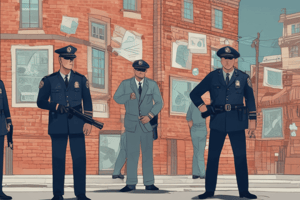Podcast
Questions and Answers
What is the primary focus of intelligence-led policing?
What is the primary focus of intelligence-led policing?
- Responding to individual calls for service as quickly as possible.
- Integrating community policing with traditional law enforcement.
- Strict enforcement of all laws regardless of impact.
- Analyzing recent incidents to develop strategies preventing future occurrences. (correct)
What is the first step in the cyclical, five-step process of intelligence-led policing?
What is the first step in the cyclical, five-step process of intelligence-led policing?
- Gather feedback regarding the value of the intelligence.
- Analyze collected data and format them into reports and briefings.
- Identify crime parameters and define priorities for data collection and analysis. (correct)
- Disseminate the intelligence to appropriate individuals for review.
Which of the situations represents a practical application of strategic policing?
Which of the situations represents a practical application of strategic policing?
- A police force collaborates with community groups and the district attorney to target those who solicit prostitutes. (correct)
- A city uses CompStat to track crime data and deploy resources to emerging hotspots.
- A police chief implements a zero-tolerance policy for minor traffic violations to reduce accidents.
- A police department increases patrols in a high-crime area based on last month's crime statistics.
What is the purpose of conducting a SWOT analysis in strategic policing?
What is the purpose of conducting a SWOT analysis in strategic policing?
What is a key difference between community policing and traditional policing strategies?
What is a key difference between community policing and traditional policing strategies?
How does zero-tolerance policing aim to reduce crime?
How does zero-tolerance policing aim to reduce crime?
Which policing style as described by James Q. Wilson, focuses on maintaining order and controlling illegal and disruptive behavior through discretion, often employing persuasion and threats rather than formal arrests?
Which policing style as described by James Q. Wilson, focuses on maintaining order and controlling illegal and disruptive behavior through discretion, often employing persuasion and threats rather than formal arrests?
According to the content, what is one of the major challenges facing U.S. police today?
According to the content, what is one of the major challenges facing U.S. police today?
Why is discretion considered a necessary aspect of police work, according to Sheehan and Cordner?
Why is discretion considered a necessary aspect of police work, according to Sheehan and Cordner?
According to Herbert Jacob, which of the following is a major factor influencing police officers in determining whether to exercise discretion?
According to Herbert Jacob, which of the following is a major factor influencing police officers in determining whether to exercise discretion?
In what types of situations did Wilson find the greatest variation in an officer’s discretion?
In what types of situations did Wilson find the greatest variation in an officer’s discretion?
What has been identified as the most significant factor in an officer forming an opinion about a suspect?
What has been identified as the most significant factor in an officer forming an opinion about a suspect?
What did Lundman and Kaufman suggest about women and police stops?
What did Lundman and Kaufman suggest about women and police stops?
According to a Pew Research Center study, what effect has increased scrutiny had on police officers?
According to a Pew Research Center study, what effect has increased scrutiny had on police officers?
What effect did the Black Lives Matter movement have on policing according to the content?
What effect did the Black Lives Matter movement have on policing according to the content?
To manage police behavior according to the text, what should agencies do?
To manage police behavior according to the text, what should agencies do?
What does effective management of discretion involve to ensure the proper value system in officers?
What does effective management of discretion involve to ensure the proper value system in officers?
What did increased numbers of incidents of police action involving Emotionally Disturbed Persons (EDP) cause police departments to do?
What did increased numbers of incidents of police action involving Emotionally Disturbed Persons (EDP) cause police departments to do?
What is the purpose of CALEA (Commission on Accreditation for Law Enforcement Agencies)?
What is the purpose of CALEA (Commission on Accreditation for Law Enforcement Agencies)?
Flashcards
Intelligence-Led Policing
Intelligence-Led Policing
A strategy integrating problem-oriented and zero-tolerance policing by continuously analyzing incidents and developing action plans.
Strategic Policing
Strategic Policing
An ingredient of community policing that integrates private- and public-sector management techniques, such as SWOT analysis.
SWOT Analysis
SWOT Analysis
Analysis of Strengths, Weaknesses, Opportunities, and Threats to evaluate an organization's ability to succeed.
Discretion
Discretion
Signup and view all the flashcards
Decisions on the street
Decisions on the street
Signup and view all the flashcards
FBI study on Police attacks
FBI study on Police attacks
Signup and view all the flashcards
Preparing for police descrition
Preparing for police descrition
Signup and view all the flashcards
Use of dicretion stress
Use of dicretion stress
Signup and view all the flashcards
The view about police discretion
The view about police discretion
Signup and view all the flashcards
Study Notes
- The chapter focuses on police operations.
- It addresses the operations aspect of police work, highlighting patrol operations and criminal investigations.
- Police officers must remember that their work is part of a larger context involving citizens and criminal justice colleagues.
- Effective communication skills are crucial for police officers, including active listening, report writing, and clear communication techniques.
- Police officer actions must be legal and ethical while developing the ability to protect themselves.
Intelligence-Led Policing
- Intelligence-led policing combines problem-oriented policing and zero-tolerance policing.
- Police analyze recent incidents and create action plans.
- Agencies use CompStat, Geographic Information Systems (GIS), and regular meetings to analyze data.
- Using Geographic Information System (GIS) technology helps police to quickly identify and respond to incidents of crime.
- Obtaining and processing information for intelligence-led policing uses a cyclical, five-step process.
- Intelligence-led policing advantages include early interception of troubling trends and implementation with other strategies.
- Challenges include the need for high technological sophistication, daily accountability, and strong community partnerships.
Strategic Policing
- Strategic policing is an element of community policing.
- Strategic policing uses SWOT (strengths, weaknesses, opportunities, threats) analysis and strategic planning.
- Agencies start by setting goals based on crime trends and directives from police chiefs or mayors, or community input.
- In strategic policing Agencies develop strategies aligned with stakeholder priorities.
- Community policing emphasizes police visibility, community rapport, fewer arrests, and decentralized command.
- Strategic policing incorporates police operations into peacekeeping and crime/disorder prevention.
- Effective strategic policing needs plans, key objectives, outcome indicators, and effective service delivery.
- It also requires community alliances to address disorder and prevent crime.
- Employees should be involved in strategic planning and be able to articulate the agency's strengths and weaknesses.
- The agency must shift from reaction/compliance.
- Strategic policing enables agencies to fulfill their mission, realize mandates, and adapt to community concerns.
- It also enhances efficiency by prioritizing resource allocation to maximize value.
SWOT Analysis
- SWOT analysis helps policing agencies focus on problems and select solutions, creating community value.
- SWOT considers the agency’s existing strengths and resources(e.g., reputation, trained personnel).
- SWOT considers the agencies vulnerabilities or weaknesses (e.g., reduced resources, high attrition).
- SWOT considers opportunities outside the agency that can enhance efficiency, such as new software or community partnerships.
- SWOT considers external developments may impede the process, such as authorized personnel reductions.
- Team objectives, rewards, training, and communications must align with agreed-upon strategies.
- Strategic policing evaluates officers beyond arrests and report completeness.
- Strategic policing requires managers and employees to understand agency goals, performance measures, and problem causes.
Strategic Policing: Pluses and Minuses
- A "plus" is that strategic policing enables an agency to fulfill its mission
- A "plus" is that strategic policing allow an agency to adapt to ever-changing community concerns.
- A "minus" is that strategic planning and thinking skills require investment of time and resources.
Policing Styles
- This strategy usually employs an authoritarian style of management.
- Police officers are controlled and directed to complete tasks.
- The model assumes that managers know best.
- This model assumes that response to events are always necessary and effective.
- This model assumes objective ways to present an unbiased view of police productivity.
Community Policing.
- Community policing encourages partnerships
- Community policing encourages interaction between the police and the public produces desired results..
- This strategy entails a shift in police from authoritarian to participatory model.
- Philosophical adjustments and attitude changes are required in police management.
Problem-Oriented Policing
- Problem-oriented policing is is the tactical implementation of community policing
- Problem-oriented policing is used to address crime and quality-of-life concerns within a community.
- Problem-solving methods, including the (Scanning, Analysis, Response, Assessment) SARA model, performance measurements, require expansion of tactics.
- Additional police training needed for police to improve leadership, community interaction strategies, and problem solving
Team Policing and Neighborhood Policing
- These strategies exemplify community policing
- Team Policing and Neighborhood Policing are implemented to solve problems on a small scale.
- Example of team policing is solving problems on a small scale.
Zero-Tolerance Policing.
- This strategy is an outgrowth of the broken windows theory
- The broken windows theory holds that minor criminal offenses increase other serious crimes occur.
- According to this strategy, police can restore order by enforcing laws related to minor offenses.
- Graffiti and Vandalism increase the likelihood that people will commit more serious crimes.
Intelligence-Led Policing.
- Intelligence-Led Policing integrates problem-oriented policing and zero-tolerance policing
- Incident occurances are continuously analyzed
- Action places are implemented to address an inciden
- CompStat software can can be used during instances when in emphasis this policing strategy
Strategic Policing.
- A strategic strategy has a element of community policing
- Techniques used are
- private- and public-sector organizational
- SWOT analysis which studies (strengths, weaknesses, opportunities, and treats.
- Strategic planning with public policing strategy
SWOT Analysis.
- SWOT Analysis is used to evaluate the organization's inclination ability to succed
- Agencies Strengths and weakness is throughly looked at
- Opportunities and threats are looked at to analyze
Policing types
- Wachman style is primarily conserned with order maintenance(contolling and maintaning illegal behavior)
- Legalistic style enfroces the Laws(Many citations made)
- Service style is on serving the community.
Police Discretion.
- Discretion means choice of options or actions
- The criminal justice system involves a amount of discretion (sentences)
Police Discretion Importance
- Discretion is very important (can't arrest everyone)
- Factors influence Discretion Factors include (character , relationship)
- Discretion must be controlled
- Prepare authorities for a situation
Commission on Accreditation for Law Enforcement Agencies (CALEA)
- Created in 1979 as a credentialing authority
-CALEA improves the delivery of public safety services
- maintains a code of standards
Studying That Suits You
Use AI to generate personalized quizzes and flashcards to suit your learning preferences.




